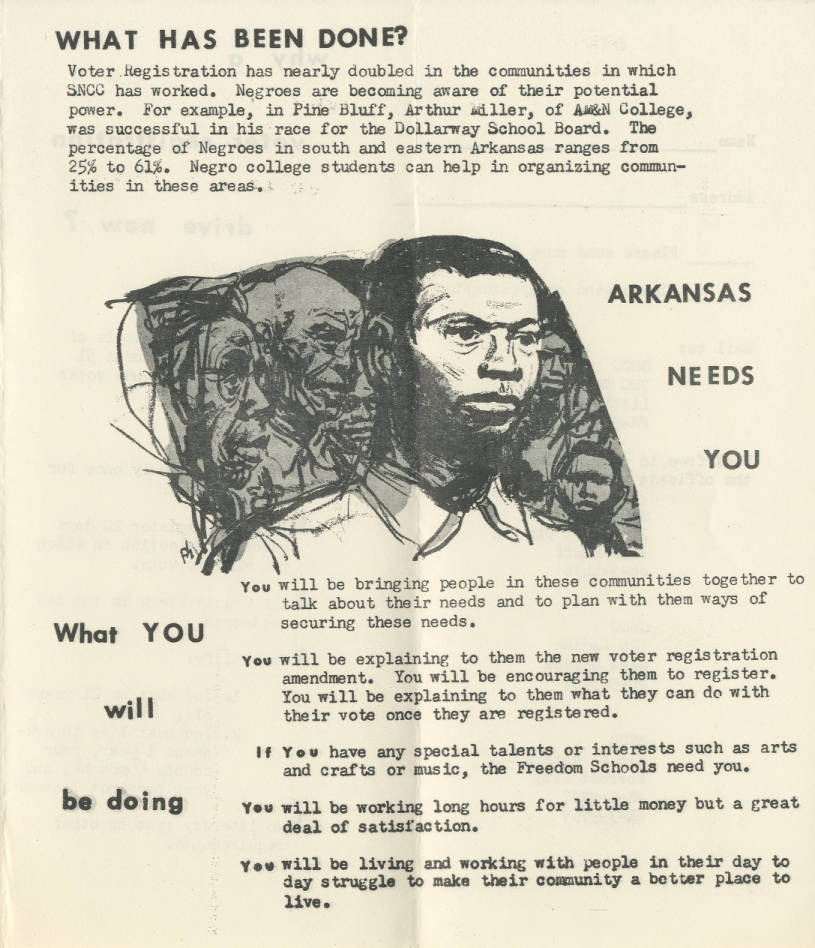The Arkansas Freedom Summer, also known as the Arkansas Summer Project, was a pivotal event in the Civil Rights Movement in Arkansas during the summer of 1965. It occurred one year after the more famous Freedom Summer in Mississippi. Michael Simmons, a Temple University student at the time, visited the Student Nonviolent Coordinating Committee (SNCC) headquarters in Atlanta, Georgia. Inspired by the Mississippi Freedom Summer the year before, Simmons initially intended to work in Mississippi. However, civil rights activist Jimmy Travis informed him that the Mississippi project was in flux. Travis encouraged Simmons to work instead in Arkansas, which he claimed “had an organized leadership with a more focused and disciplined project.”
Simmons heeded Travis’ advice and became a part of the Arkansas Freedom Summer Project. This initiative invited 50 volunteers who traveled to Arkansas during the summer of 1965, with a primary focus on voting registration. At the time, the Arkansas state legislature had just passed a new voter registration law that abolished the poll tax in state and local elections. SNCC saw this as an opportunity to expand the number of African Americans on the voting rolls in Arkansas. The plan was for the summer volunteers to facilitate the expansion of the Arkansas Project into 31 counties and towns, such as Forrest City, Marianna, and Blytheville. The project also encompassed the establishment of Freedom Schools, community centers, and cultural programs. When Simmons arrived in Arkansas, he was assigned to West Helena, where he organized voter registration and encouraged Black farmers to participate in the Agricultural Stabilization and Conservation Services (ASCS) elections. This was a significant step in empowering the Black community in Arkansas.
The local Freedom School, a key component of the project, attracted one hundred participants. Led by Myrtle Glascoe, the students studied Black history and current events. They also frequently discussed the poor quality of segregated and underfunded public education. This led to a school boycott in Marvell, Arkansas, demanding integrated facilities the following school year. Over three-quarters of the student body went on strike for six weeks, eventually forcing the local school board to desegregate the public school.
On August 5, 1965, the Voting Rights Act of 1965 was passed, which prohibited racial discrimination in voting. However, the struggle for equality continued in Arkansas. Gertrude Jackson in Marvell, Arkansas, and Carry Dilworth of Gould, Arkansas, continued to fight for school equality. Young people in Little Rock, Arkansas, formed the Black United Youth (BUY) to fight for fair employment practices for Black people for the remainder of the decade. Arkansas Freedom Summer projects and activities demonstrated the enduring impact of the Civil Rights Movement on one state and the broader Civil Rights Movement.
Do you find this information helpful? A small donation would help us keep this available to all. Forego a bottle of soda and donate its cost to us for the information you just learned, and feel good about helping to make it available to everyone.
BlackPast.org is a 501(c)(3) non-profit and our EIN is 26-1625373. Your donation is fully tax-deductible.
“Arkansas Freedom Summer,” Digital SNCC Gateway, https://snccdigital.org/events/freedom-summer-arkansas/; Bill Hansen, “Arkansas Daze,” Arsnick: The Student Nonviolent Coordinating Committee in Arkansas, edited by Jennifer Jensen Wallach and John A. Kirk (Fayetteville: The University of Arkansas Press, 2011); Michael Simmons, “Arkansas Roots and Consciousness,” in Arsnick: The Student Nonviolent Coordinating Committee, edited by Jennifer Jensen Wallach and John A. Kirk (Fayetteville: The University of Arkansas Press, 2011).

